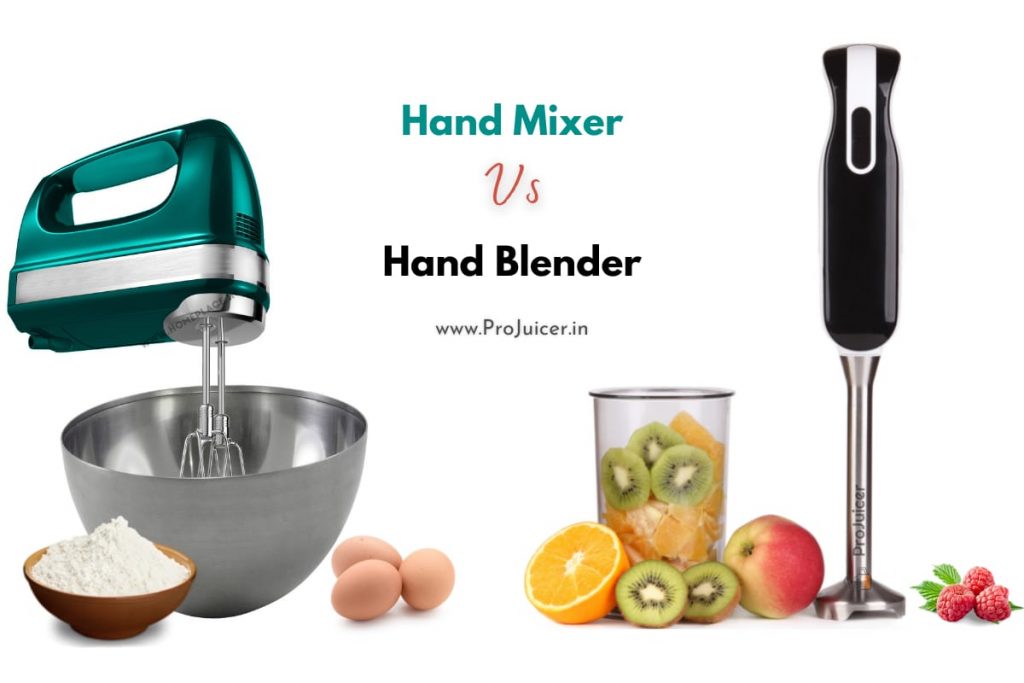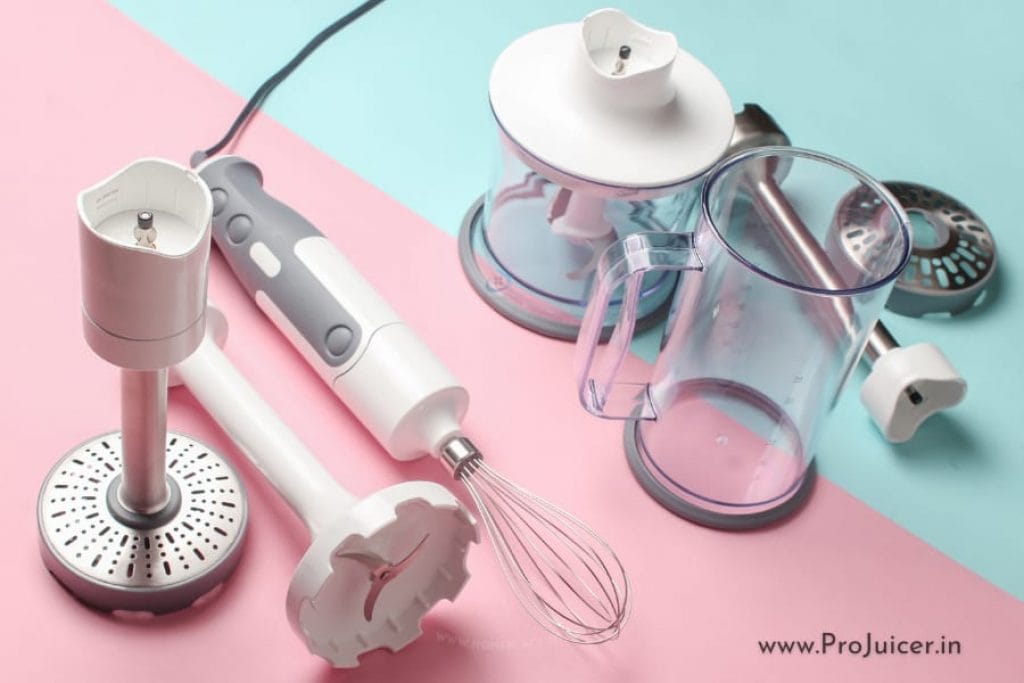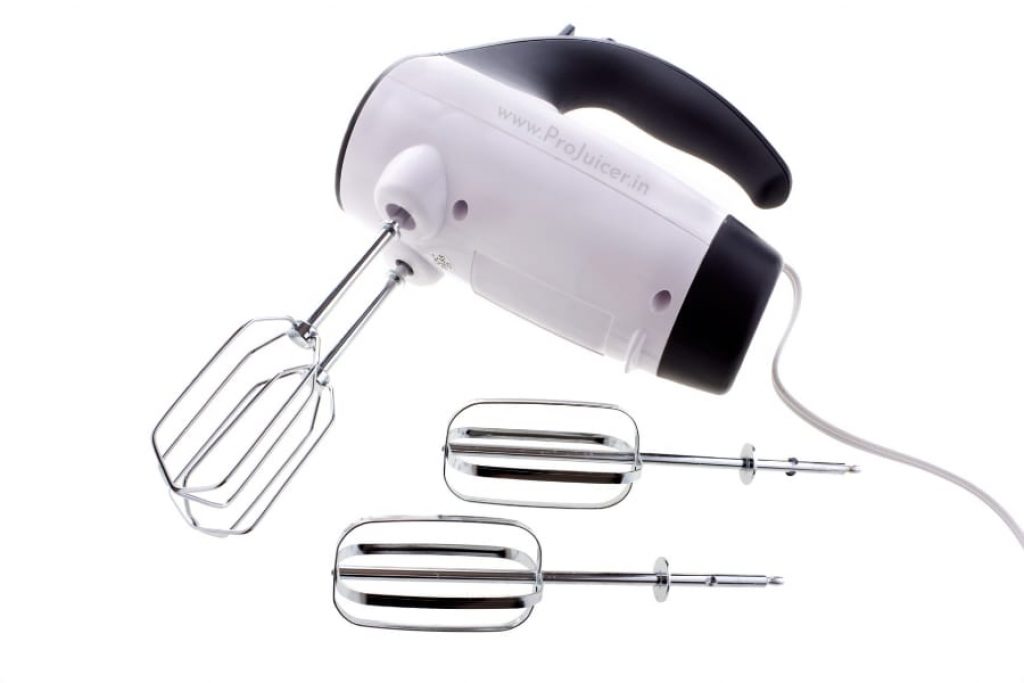Hand blenders and hand mixers have proven to be power-packed yet compact machines. While they both pack enormous value, you should not confuse one with the other. They both are different, no matter how similar they sound.
Now that you know there is a difference, you may wonder where exactly these devices diverge paths. What’s their best use?
And most important of all, which one will suit you better?
The hand blender vs. hand mixer debate has been going for years, with newer and improved models coming into the market every year. Let’s discuss both sides concerning the advantages, disadvantages, and best uses in this article.

Comparison of Hand Blender Vs. Hand Mixer
| Point of Difference | Hand Blender | Hand Mixer |
|---|---|---|
| Purpose | Hand blenders, as the name suggests, are used to blend ingredients or purée food. | Hand mixers perform exceptionally well when it comes to beat, whip, and mix ingredients. |
| Applications | Hand blenders can make purée out of cooked vegetables, prepare baby food, prepare a smoothie, etc. | You can use electric hand mixers to prepare the cake batter, bind small quantities of dough, churn homemade butter, etc. |
| Versatility | Electric hand blenders can do a lot more than just blending with the right attachments. The versatility of these blenders is higher. | Hand mixers also come with many attachments, but the motor inside is less powerful, decreasing their versatility. |
| Size, Weight, Usability | Hand blenders have an elongated stick-like structure and generally weigh around 1 kg. | Hand mixers or electric beaters contain a solid casing that houses the motor and has a wider shape. They generally weigh around 1 kg. |
| Power Consumption | The power consumption of a hand blender typically ranges from 150 watts to 400 watts. | The power consumption of a hand mixer typically ranges from 150 watts to 300 watts. |
| Price | The price range of electric hand blenders- Rs. 700 to Rs. 3000. | The price range of hand mixers- Rs. 600 to Rs. 3000. |
Key Differences Between Hand Mixer and Blender
Purpose Of Hand Blender And Mixer
It’s the primary goal that you want to achieve with the appliance. More specifically, purpose refers to what your machine should be primarily used for?
In that case, both hand blenders and hand mixers are remarkably versatile and multi-purpose items. However, the main aim of hand blenders is to blend ingredients. Likewise, hand mixers excel in mixing, beating, and whipping ingredients. All thanks to the twin beaters rotating in opposite directions.
Hand Mixer Vs. Blender : Applications
As mentioned above, both hand mixers and hand blenders are multi-purpose items and can be used for various tasks. Their range of applications becomes even broader with the attachments at hand.
Typically, you can use hand blenders to make vegetable purée, baby food, and a delicious cup of smoothie to complement your daily nutrition intake. On the other hand, hand mixers can be used to make whipping cream, cake batter, etc.
Which One Is More Versatile?
Hand blenders and hand mixers share the same level of versatility. For example, you can use electric hand blenders to do more than they’re supposed to (e.g., whipping cream). Likewise, you can extend the usability of electric hand mixer with the right attachments.
However, as a rule of thumb, hand blenders are generally more versatile thanks to a comparatively powerful motor.
Size/Weight/Usability Of Hand Blender And Mixer
The size and weight of a kitchen appliance become significant when storing the appliance in cluttered spaces. However, both immersion blenders and hand mixers do a remarkable job of keeping the size and weight in check. The only difference is the shape. Immersion blenders have a stick-like structure and can be stored anywhere you see fit.
On the other hand, electric beaters have a somewhat wider body and take more storage space than immersion blenders or hand blenders. They share the same weight, which generally stays under 1 kg.
Hand Blender Vs. Hand Mixer: Power Consumption
Since most hand blenders and hand mixers are electric, you may define their power consumption as the wattage or the input energy required to function correctly.
In that case, hand blenders and hand mixers share an almost identical power consumption. The power consumption of hand blenders and hand mixers typically ranges from 150 watts to 400 watts and 150 watts to 300 watts, respectively. Some high-end models of mixers can go beyond this range, though they’re rare and expensive.
Cost Of The Two Kitchen Appliances
In the pricing department, hand blenders and hand mixers practically stand on the same ground. However, the starting models of mixers are priced comparatively cheaper. In any case, an average hand blender costs close to somewhere around Rs. 2000. This average pricing is more or less the same for electric beaters.
Why Should You Get A Hand Blender?
An electric hand blender, known by many names such as stick blender, immersion blender, mini blender, and wand blender, is a compact yet powerful device to blend ingredients perfectly. It functions similar to a spoon while blending food; it’s just that you don’t need to stress your muscles a lot. It can be used as an affordable and effective replacement.

How Does A Hand Blender Work?
Hand blenders and full-blown blenders, while they both do essentially the same job, the approach is entirely different. Hand blenders are compact handheld devices and have a heavy-duty motor powering sharp blades at the bottom of the device. These fast-rotating blades blend ingredients without making much noise, unlike full-blown blenders.
However, getting used to hand blenders takes time. You may not be able to work with hand blenders without spilling the ingredients.
Advantages Of Hand Blenders
- Small and Highly Portable: Hand blenders, compared to hand mixers, are very small and compact. Still, they pack excellent features for the price. They’re small and have a wand-like structure that’s easy to hold and carry around, making them highly portable. As a result, they’re lightweight, which adds more to these devices’ portability.
- Plenty of Uses (Versatile): Although the name says hand blenders, these devices can do much more than just blend. From delicious morning smoothies to baby food, the best hand blenders are versatile and handy enough to do it all without a hitch. What’s more? Immersion blenders come with extra attachments to increase their versatility even further. For example, with proper attachments, you can use them to beat eggs, make whipped cream, or even cut vegetables. One may argue that they eliminate the requirement of an expensive full-blown food processor.
- Affordable: Despite providing such enormous usability, hand blenders aren’t expensive, not even close. These small yet powerful devices are so affordable that you can quickly grab one for a couple of thousand rupees. They seem even cheaper if you compare them with full-blown food processors. The latter can easily make you break the bank; hand blenders come at a fraction of that price.
- Efficient: While working with hand blenders, you can directly blend ingredients in your cooking pot, saving time and energy. Hand or immersion blenders also allow you to work with slightly large quantities. That’s because the size of the blending bowl no longer limits you. The best part is that you no longer need the ingredients to be cooled down. Your immersion blender can effortlessly work with hot ingredients. This results in dramatic time savings, especially when you’re preparing soup.
- Silent Operation: Hand blenders do not produce a lot of noise, unlike full-blown bulky blenders. They’re virtually silent primarily because of a solid casing over the motor of the hand blender. All the sound that an immersion blender produces stays inside the casing, allowing a silent operation.
- Effortless Cleaning: Immersion blenders do not mess up your kitchen space at all, unlike countertop blenders. It’s only the bottom parts of an immersion blender that needs cleaning, just toss them into your dishwasher, and you’re good to go. However, make sure to read the cleaning instructions carefully before doing so. The cleaning process can differ slightly from manufacturer to manufacturer. As for the rest of the blender’s body, just wipe it with a soap water-dipped cloth to get rid of minor stains.
Hand Blender Disadvantages
- Not Helpful for Stiff Ingredients: Compared to the motor and blades of a full-blown countertop blender, the motor of hand blenders stands no chance. This comparatively weak motor limits hand blenders to effectively work with soft ingredients only (e.g., cake batter). In such a case, using countertop blenders is the most recommended option.
- Must be Handled with Care: The sharp blades of immersion blenders are mostly exposed. They can cause significant injuries to the user if not handled with care. This becomes even more concerning for children as they’re more prone to such accidents. Many accidents concerning hand blenders have been reported throughout the years. So, if you do decide to get an immersion blender to take care of your kitchen chores, make sure to read the instructions carefully. In contrast, countertop blenders are much safer.
- Less Stable: A light handheld appliance will be less stable than a heavy appliance that remains stationary. So, hand blenders are comparatively less sturdy and demand a firm grip to avoid slippage. It’s always better to check the grip of an electric hand blender before purchasing it.
- Can Splash Ingredients: As mentioned before, using hand blenders without spilling food is no joke; they demand a bit of experience. So, it’s safe to say that this kitchen appliance isn’t beginner-friendly at all. Moreover, even if you know how to use a hand blender effectively, occasional splashes are inevitable.
Ideal Uses Of Hand Blenders
- Making Smoothies and Milkshakes: Nothing works seamlessly than a hand blender when making smoothies and milkshakes. The blades are powerful enough to tackle frozen fruits and ice cubes and whip frothy beverages. Exactly what you need to kick-start your day with a delicious mixed-fruit smoothie.
- Making Whipped Cream: No need to struggle with stand mixers anymore. Immersion blenders can prepare whipped cream for you in mere minutes.
- Beating Eggs: Preparing omelets and scrambled eggs for breakfast has never been this easier. Immersion blenders work astoundingly well when it comes to beating eggs. Their function is much more effective as compared to beating with forks and spoons. Meanwhile, beating eggs with hand blenders also ensures that the yolks and egg whites are uniformly combined.
Why Are Hand Mixers Excellent?
A hand mixer is a handheld device (primarily electric) that is used to mix ingredients as the name gives it away. It’s an enclosure that houses the motor. The motor powers a set of beaters through a gear-driven mechanism to get you through all your mixing, whisking, and beating tasks. The motor of a hand mixer is lightweight yet powerful enough to get you through most of your cooking chores, including whisking and beating.

How Does A Hand Mixer Work?
A hand mixer uses several components in perfect tandem to achieve the desired results. Typically, an electric hand mixer uses two beaters that rotate in the opposite directions with the same speed. These are oppositely rotating beaters whip and beat the ingredients through and through. This operation, while saving power, provides you with a uniform and homogenous mixture. Just attach the beaters to the hand mixer and use it to get the job done.
Advantages Of Hand Mixers
- Inexpensive: Hand mixers are almost similarly priced as hand blenders. Affordability makes them highly accessible by the majority. You can quickly get your hands on a good quality electric hand mixer for just about Rs. 800. The price can go up to Rs. 3000 depending on the features.
- Ideal for Cluttered Kitchen Spaces: Hand mixers were designed keeping the size, weight, and portability in mind. As a result, electric hand mixers are incredibly portable and do not demand a lot of storage space, making them ideal for cluttered areas. Hand mixers come in handier for daily use.
- Exceedingly Power-efficient: Hand mixers consume similar electricity as compared to hand blenders. That’s primarily because of the small and energy-efficient yet powerful motor that a hand mixer incorporates.
- Single-Hand Usage: Mixers are so light that you should encounter no issues using them even with one hand. The size of these portable mixers is also minimal, which contributes to better single-hand usage.
- Come with Multiple Attachments: Most hand mixers can be equipped with different attachments to help you get the most out of your mixer. Like a juicer mixer grinder, these attachments can even help you do more than just mixing.
Hand Mixer Limitations
- Not Helpful in Dealing with Large Quantities: The motor incorporated in hand mixers is small and insignificant for large quantities. You can use them to beat, whip, or mix small amounts of food only. They’re also not powerful for large batches.
- Occasional Splashing: To make a hand mixer work effectively, you must move the mixer across the bowl. This can encounter occasional splashing if not appropriately handled. You can say hand mixers have a bit of a learning curve associated with them and are not friendly to absolute beginners.
- Not Very Effective in Mixing Thick Batter: The consistency of the batter needs to be perfect, or the hand mixer won’t work. The motor is not powerful enough to run the beaters through a thick batter. If you do mix thick batter quite frequently, hand mixers may not be the best choice for you; consider using a powerful hand blender in that case.
Vital Uses Of Hand Mixers
- Preparing Cake Batter: Making cakes or muffins to satisfy your midnight cravings has never been this easy before. From whipping cream to whisking eggs, hand mixers can take care of every step of preparing the cake batter.
- Making Lassi: What can soothe your body better than lassi on a hot summer day? Thanks to electric hand mixers, soul-refreshing lassi is only minutes away. Hand blenders also work exceptionally well with buttermilk.
- Binding Dough: Although in small quantities, hand mixers can be used to bind the dough effectively. However, you need to purchase a separate electric beater hook attachment to fulfill this need.
Conclusion: Hand Mixer vs. Hand Blender
Hand blenders and hand mixers are versatile, affordable, and come with a lots of attachments to extend their usability. However, it’s almost impossible to pick a clear winner here considering the number of features they share (e.g., price, wattage, weight, etc.).
Still, if we take the motor as the key determining factor, hand blenders take a slight lead, though not marginally. So, to sum it up, both hand blenders and hand mixers share the same potential and can do wonders with the right attachments equipped.
The best part is that these are incredibly affordable; they won’t hinder your monthly budget even if you decide to purchase both of them.
Also Read:

